&
Surrounding Ruins
Oaxaca, Oaxaca, Mexico.
Travel & Tour
Pictures, Photos, Information, Images, & Reviews.
George & Eve DeLange
Google Map To Oaxaca, Oaxaca, Mexico.
View Larger Map
Click On Any Of The Following Links By Amazon.Com
For Books Or Videos About The Zapotec People, In Mexico. No Obligation!
Oaxaca (pronounced "Wah-HA-Ca"): The name Oaxaca comes from the word, Huaxyacac, which is the Nahuatl word for "the place of the seed pots." There is a reason that the word Huaxyacac was used. This we will explain in the next paragraph.
The Valley of Oaxaca is really three valleys, which spread apart, like the thumb, index finger, and middle finger of a hand, from a single point. The Aztec conquerors, which spoke Nahuatl, called that point Huaxyacac (yoo-AHSH-yah-kahk), "Point of the Calabash Gourd Hill." Named for the hill of Calabash gourd-bearing trees, which once covered the hill.
The Spanish, who later on, founded the city at the foot of the Huaxyacac Hill, changed that name to the more easily pronounced name, Oaxaca.
The Central Valley of Oaxaca is a mountain highland, encompassing 3,375 square kilometers (1,303 square miles) at an elevation of approximately 1,550 meters (5,115 feet). A central ridge system furthermore divides the valley into three separate, smaller valleys: the Tlacolula Valley, extending 50 km east; the Etla Valley, extending 40 km north; and the Zimatlan Valley, which extends 100 km south to Miahuatlan, where the land rises before dropping into the lowlands of the Isthmus of Tehuantepec.
Since there are two uses of the word Oaxaca, first time travelers to Oaxaca sometimes get them confused. There is Oaxaca, a State in Mexico. And Oaxaca, the Capital City of Oaxaca State. The Capital City of Oaxaca is officially called, "Oaxaca de Juárez."
The State of Oaxaca is located in the Southeastern region of Mexico; it borders on the North with Veracruz and Puebla, the Pacific Ocean on the South, Chiapas on the East, and Guerrero on the West.
Oaxaca State has a very pleasant sub-tropical climate and the serenity of its surrounding countryside attracts many visitors to the Oaxaca Valley. Oaxaca has majestic mountain peaks about 10,000 feet high, its caverns are among the deepest in the world, it has virgin beaches, hidden jungles, and beautiful valleys that house the populations where the cultures of all people who once lived in their midst have come together.
Eighteen cultures once lived in the Oaxaca Valley: the Zapotecs, Mixtecs, Mazatecs, Chinantecas, Triquis, Chontales, Chatinos, Mixes, Amuzgos, Huaves, Zoques, Chontales, Chatinos, Ixtaltecas, Chonchos, Popolacas, Cuicatecas and Nahuas.
Today there are 16 ethnic groups, not counting the Spanish, among the 4.5 million people in the State Of Oaxaca, some 650,000 of who live in Oaxaca de Juárez. This makes Oaxaca the most diverse state in Mexico.
In the city of Oaxaca, Native Indians sell their craftwork in the city square, called the Zocalo; they even wear their regional costumes. Many Native Indian groups sell all types of vegetables and finished goods in the city's central market, located just a few blocks from the Zocalo. At this market you can sample the fried grasshopper or the local braided cheeses.
While there are many ancient cities and their ruins in the State of Oaxaca, there are a few that have been excavated and they are certainly worth traveling to. Fortunately most of them are near the city of Oaxaca and they can be reached in a very short drive from the city. I will mention a few of the most easy to get to and more popular ruins.
Monte Alban is built at the junction of three broad valleys, across from the Atoyac stream, lays a series of large hills. The largest of these hills is nearly 400 meters above sea level. It was on the top of this mountain, which the Zapotecs leveled off and built into a great ceremonial city in about the year 500 ad. This center once ruled the entire region. The city is now known as Monte Alban. Monte Alban, or "White Mountains" in Spanish, was formerly called Danibaan (Sacred Mountain). No visit to Oaxaca can be considered complete without visiting Monte Alban.
Mitla was occupied until the 16th century when the Spaniards destroyed or dismantled an Indian building in order to use the foundation and many of the cut bricks from the original city to build a cathedral. What we now call the Town of Mitla grew up around the ruins (and cathedral), which makes an interesting contrast between a once beautiful and great city in ruins and the current city, which has never regained the stature of the pre-Spanish era. If you have the time, this is the number two (after Monte Alban) must see site near Oaxaca.
Cuilapan: The monastery and church, which were built here in the 16th century, indicate that this was once an important Mixtec population center. If you go, inquire about the little explored ruins on the other side of the Valientne River, which contain a pyramid (probably from Monte Alban period 4) built as a consequence of a tomb (as was the reason for one of the pyramids found in Palenque).
Dainzu: Though most of this once large city remains un-excavated, what is known suggests that the city was largely contemporary with Monte Alban. The ruins here are currently worth seeing just as much as the ruins at Mitla, and if the site is ever completely excavated, it will become one of the best sites in the area.
Lambityeco: Most of this city is also un-excavated, but what has been found so far suggests that the city reached its peak during the decline of Monte Alban (aprox. 700 AD). The human characters sculpted in stucco are probably the most recognizable feature in Lambityeco. Worth seeing if you have the time.
Yagul: There is plenty to see at Yagul (thought to be contemporary with Mitla) like tombs, the largest ball court found in the Oaxaca Valley, fretted stone mosaics, the ruins on the acropolis, and the huge defensive walls of the fortress at the top of the hill. A good place to see on the way back from Mitla.
Zaachila: The last Zapotec capital from which the names of a number of rulers are known. There is a huge (mostly unexplored) pyramid in the center of town and a series of large stones with hieroglyphs to one side of the main plaza.
San José el Mogote: : Located 12 kilometers (7.5 miles) northwest of Oaxaca City. Travel time is about 30 minutes. The famous archeological site of San Jose el Mogote can be found at the "spur" of the Oaxaca piedmont projecting out toward the Atoyac River at 1610 meters above sea level only 7.46 miles north-west of Oaxaca City headed for the village of Elta. San Jose the Wooded Hill is considered one of the more important Mesoamerican establishments of the Valley of Etla in Oaxaca. it has a Community Museum, housed in the former "El Cacique" Hacienda.
The museum includes an extraordinary collection of archaeological pieces. The most famous figure is a red-colored jade effigy known as "El Diablo Enchilado" recently honored by its depiction in the Noche de Rabanos.
Teotitlan del Valle: Weaving center, known for bright serapes with idol designs. It was the capital of the Zapotec during 11th and 12th century. A temple and pyramid in honor of Quetzalcoatal are on a hill nearby. The Saint Hieronymite Tlacochahuaya Church contains several original 16th century native paintings.
Huijazoo: An important archaeological site. Located 29 kilometers to the north of the city of Oaxaca, now the capital of the State, in Etla Valley which is part of the municipality of Suchilquitongo. It contains the "Tomb of Huijazoo" which dates from the Classical Period of the Zapotec culture (650-900 BC). INAH will not permit visits inside the tomb by the general public. To arrive at the site one must cross the town of Suchilquitongo, and travel down two kilometers of narrow road, then continue on foot for the next 60 meters. At the site there is an esplanade made up of three mounds.
The middle one is the principal pyramid, with a stone cross on the top where the people of the nearby town venerate their patron saint every year. On the right side of this mound is another which is as yet unexplored. On the left there is another small mound and under this one we find the tomb. The entrance is strategically placed: all approaching roads can be clearly seen.
There are several festivals in Oaxaca and We will mention a few of the promenent ones below.
Guelaguetza: The festivities of "Lunes del Cerro" are celebrated in the City of Oaxaca the two following Mondays after July 16th. This ancient Indian festival is dedicated to the gods of rain and fertility. Celebrations center around indigenous dance, music and elaborate costumes. Book Early!
Noche de Los Rabanos: The fanciful Night of the Radishes celebration takes place on December 23 as a sort of harvest festival. Farmers and artisans display hybrid and carved radishes depicting everything from nativity scenes to space travel.
Dia de Los Muertos: especially colorful and traditional celebration of All Saints Day. Festivities include elaborate decoration of altars and grave sites to welcome the brief return of the dearly departed. Oct. 24 - Nov. 2
Food of the gods festival: With seventeen indigenous Indian groups from the Oaxacan valleys, mountains and coastal regions, Oaxaca's robust cuisine offers a wide variety of tastes and textures, lifting basically peasant food to incredible heights of culinary sophistication. These timeless flavors were enhanced by the skills of the early convent nuns and perfected by present day chefs. This festival explores the Oaxacan cuisine, both pre-Hispanic and its modern variations. October 13-20
There are several photos of the above mentioned sites below. There are links to the sites that you can click on to see more detailed photos and descriptions.
Click On Any Of The Following Links By Amazon.Com
For Books Or Videos About Oaxaca Mexico. No Obligation!
The Xoxocotlán International airport (IATA: OAX, ICAO: MMOX) Is the international airport located at Oaxaca, Oaxaca, Mexico. It handles the national and international air traffic for the city of Oaxaca.
We have links on this page that will connect you with flights into and out of the Xoxocotlán International airport and allow you to book any of several of the best hotels in Oaxaca.
We suggest getting a hotel and then letting them arrange either a car or a tour of Oaxaca. If you call their Concierge Services ahead of your arrival, all of this can be pre-arranged for you.
We do this all the time, when traveling in Mexico. It is safe and it works!!! We have never experienced a problem, doing it this way!
We have placed links to Priceline.com on this page so you can arrange your flights into and out of Oaxaca; as well as your hotel, when visiting this area. We found that generally speaking, they provide the best hotel and air flight prices into Oaxaca.
Click On Images Below To Go To Their Web Pages.
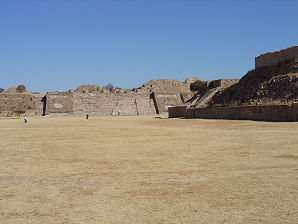
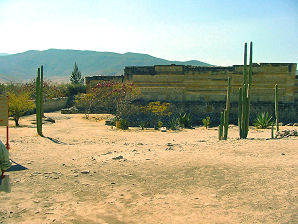
Monte Alban Mitla 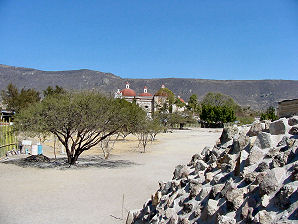
San Pablo Church, Mitla Cuilapan Monastery And Church 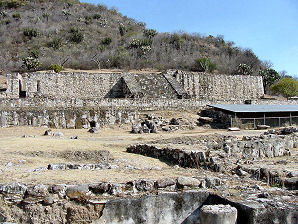
Dainzú Lambityeco 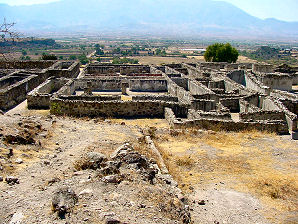
Yagul Zaachila 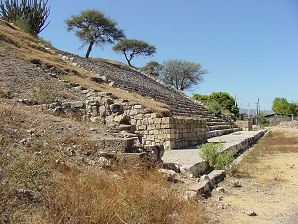
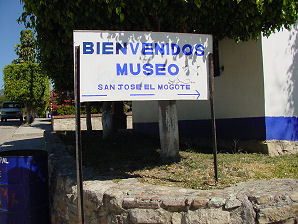
San José el Mogote San José el Mogote
Community Museum 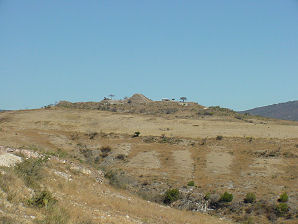
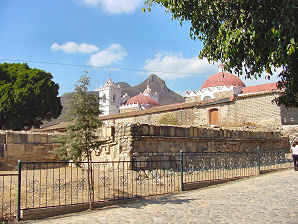
Huijazoo Teotitlan del Valle
We Are Proud Of Our SafeSurf Rating!
Click On Any Of The Following Links By Amazon.Com
For Books Or Videos About Touring In Mexico. No Obligation!
Click On The Bottom Link Marked GO, Then Look At The Bottom Of The Page That Comes Up.
There You Will See Travel Agencies That Are Recommended By Amazon.Com
For Touring In Mexico. No Obligation!
Here Are Some Links To The Very Best & Most Popular Items Sold On Amazon.Com
To Learn More! Click The Links Below. No Obligation, Of Course!
Other Oaxaca Region Ruins & Attractions!
Oaxaca (pronounced "Wah-HA-Ca"): The name Oaxaca comes from the word, Huaxyacac, which is the Nahuatl word for "the place of the seed pots." There is a reason that the word Huaxyacac was used. This we will explain in the next paragraph. The Valley of Oaxaca is really three valleys, which spread apart, like the thumb, index finger, and middle finger of a hand, from a single point. The Aztec conquerors, which spoke Nahuatl, called that point Huaxyacac (yoo-AHSH-yah-kahk), "Point of the Calabash Gourd Hill." Named for the hill of Calabash gourd-bearing trees, which once covered the hill. The Spanish, who later on, founded the city at the foot of the Huaxyacac Hill, changed that name to the more easily pronounced name, Oaxaca. The Central Valley of Oaxaca is a mountain highland, encompassing 3,375 square kilometers (1,303 square miles) at an elevation of approximately 1,550 meters (5,115 feet). A central ridge system furthermore divides the valley into three separate, smaller valleys: the Tlacolula Valley, extending 50 km east; the Etla Valley, extending 40 km north; and the Zimatlan Valley, which extends 100 km south to Miahuatlan, where the land rises before dropping into the lowlands of the Isthmus of Tehuantepec. Since there are two uses of the word Oaxaca, first time travelers to Oaxaca sometimes get them confused. There is Oaxaca, a State in Mexico. And Oaxaca, the Capital City of Oaxaca State. The Capital City of Oaxaca is officially called, "Oaxaca de Juárez." The State of Oaxaca is located in the Southeastern region of Mexico; it borders on the North with Veracruz and Puebla, the Pacific Ocean on the South, Chiapas on the East, and Guerrero on the West. Oaxaca State has a very pleasant sub-tropical climate and the serenity of its surrounding countryside attracts many visitors to the Oaxaca Valley. Oaxaca has majestic mountain peaks about 10,000 feet high, its caverns are among the deepest in the world, it has virgin beaches, hidden jungles, and beautiful valleys that house the populations where the cultures of all people who once lived in their midst have come together. Eighteen cultures once lived in the Oaxaca Valley: the Zapotecs, Mixtecs, Mazatecs, Chinantecas, Triquis, Chontales, Chatinos, Mixes, Amuzgos, Huaves, Zoques, Chontales, Chatinos, Ixtaltecas, Chonchos, Popolacas, Cuicatecas and Nahuas. Today there are 16 ethnic groups, not counting the Spanish, among the 4.5 million people in the State Of Oaxaca, some 650,000 of who live in Oaxaca de Juárez. This makes Oaxaca the most diverse state in Mexico. In the city of Oaxaca, Native Indians sell their craftwork in the city square, called the Zocalo; they even wear their regional costumes. Many Native Indian groups sell all types of vegetables and finished goods in the city's central market, located just a few blocks from the Zocalo. At this market you can sample the fried grasshopper or the local braided cheeses. While there are many ancient cities and their ruins in the State of Oaxaca, there are a few that have been excavated and they are certainly worth traveling to. Fortunately most of them are near the city of Oaxaca and they can be reached in a very short drive from the city. I will mention a few of the most easy to get to and more popular ruins. Monte Alban is built at the junction of three broad valleys, across from the Atoyac stream, lays a series of large hills. The largest of these hills is nearly 400 meters above sea level. It was on the top of this mountain, which the Zapotecs leveled off and built into a great ceremonial city in about the year 500 ad. This center once ruled the entire region. The city is now known as Monte Alban. Monte Alban, or "White Mountains" in Spanish, was formerly called Danibaan (Sacred Mountain). No visit to Oaxaca can be considered complete without visiting Monte Alban. Mitla was occupied until the 16th century when the Spaniards destroyed or dismantled an Indian building in order to use the foundation and many of the cut bricks from the original city to build a cathedral. What we now call the Town of Mitla grew up around the ruins (and cathedral), which makes an interesting contrast between a once beautiful and great city in ruins and the current city, which has never regained the stature of the pre-Spanish era. If you have the time, this is the number two (after Monte Alban) must see site near Oaxaca. Cuilapan: The monastery and church, which were built here in the 16th century, indicate that this was once an important Mixtec population center. If you go, inquire about the little explored ruins on the other side of the Valientne River, which contain a pyramid (probably from Monte Alban period 4) built as a consequence of a tomb (as was the reason for one of the pyramids found in Palenque). Dainzu: Though most of this once large city remains un-excavated, what is known suggests that the city was largely contemporary with Monte Alban. The ruins here are currently worth seeing just as much as the ruins at Mitla, and if the site is ever completely excavated, it will become one of the best sites in the area. Lambityeco: Most of this city is also un-excavated, but what has been found so far suggests that the city reached its peak during the decline of Monte Alban (aprox. 700 AD). The human characters sculpted in stucco are probably the most recognizable feature in Lambityeco. Worth seeing if you have the time. Yagul: There is plenty to see at Yagul (thought to be contemporary with Mitla) like tombs, the largest ball court found in the Oaxaca Valley, fretted stone mosaics, the ruins on the acropolis, and the huge defensive walls of the fortress at the top of the hill. A good place to see on the way back from Mitla. Zaachila: The last Zapotec capital from which the names of a number of rulers are known. There is a huge (mostly unexplored) pyramid in the center of town and a series of large stones with hieroglyphs to one side of the main plaza. San José el Mogote: : Located 12 kilometers (7.5 miles) northwest of Oaxaca City. Travel time is about 30 minutes. The famous archeological site of San Jose el Mogote can be found at the "spur" of the Oaxaca piedmont projecting out toward the Atoyac River at 1610 meters above sea level only 7.46 miles north-west of Oaxaca City headed for the village of Elta. San Jose the Wooded Hill is considered one of the more important Mesoamerican establishments of the Valley of Etla in Oaxaca. it has a Community Museum, housed in the former "El Cacique" Hacienda. The museum includes an extraordinary collection of archaeological pieces. The most famous figure is a red-colored jade effigy known as "El Diablo Enchilado" recently honored by its depiction in the Noche de Rabanos. Teotitlan del Valle: Weaving center, known for bright serapes with idol designs. It was the capital of the Zapotec during 11th and 12th century. A temple and pyramid in honor of Quetzalcoatal are on a hill nearby. The Saint Hieronymite Tlacochahuaya Church contains several original 16th century native paintings. Huijazoo: An important archaeological site. Located 29 kilometers to the north of the city of Oaxaca, now the capital of the State, in Etla Valley which is part of the municipality of Suchilquitongo. It contains the "Tomb of Huijazoo" which dates from the Classical Period of the Zapotec culture (650-900 BC). INAH will not permit visits inside the tomb by the general public. To arrive at the site one must cross the town of Suchilquitongo, and travel down two kilometers of narrow road, then continue on foot for the next 60 meters. At the site there is an esplanade made up of three mounds. The middle one is the principal pyramid, with a stone cross on the top where the people of the nearby town venerate their patron saint every year. On the right side of this mound is another which is as yet unexplored. On the left there is another small mound and under this one we find the tomb. The entrance is strategically placed: all approaching roads can be clearly seen. There are several festivals in Oaxaca and We will mention a few of the promenent ones below. Guelaguetza: The festivities of "Lunes del Cerro" are celebrated in the City of Oaxaca the two following Mondays after July 16th. This ancient Indian festival is dedicated to the gods of rain and fertility. Celebrations center around indigenous dance, music and elaborate costumes. Book Early! Noche de Los Rabanos: The fanciful Night of the Radishes celebration takes place on December 23 as a sort of harvest festival. Farmers and artisans display hybrid and carved radishes depicting everything from nativity scenes to space travel. Dia de Los Muertos: especially colorful and traditional celebration of All Saints Day. Festivities include elaborate decoration of altars and grave sites to welcome the brief return of the dearly departed. Oct. 24 - Nov. 2 Food of the gods festival: With seventeen indigenous Indian groups from the Oaxacan valleys, mountains and coastal regions, Oaxaca's robust cuisine offers a wide variety of tastes and textures, lifting basically peasant food to incredible heights of culinary sophistication. These timeless flavors were enhanced by the skills of the early convent nuns and perfected by present day chefs. This festival explores the Oaxacan cuisine, both pre-Hispanic and its modern variations. October 13-20 There are several photos of the above mentioned sites below. There are links to the sites that you can click on to see more detailed photos and descriptions.
|
Click On Any Of The Following Links By Amazon.Com
For Books Or Videos About Oaxaca Mexico. No Obligation!
The Xoxocotlán International airport (IATA: OAX, ICAO: MMOX) Is the international airport located at Oaxaca, Oaxaca, Mexico. It handles the national and international air traffic for the city of Oaxaca.
We have links on this page that will connect you with flights into and out of the Xoxocotlán International airport and allow you to book any of several of the best hotels in Oaxaca.
We suggest getting a hotel and then letting them arrange either a car or a tour of Oaxaca. If you call their Concierge Services ahead of your arrival, all of this can be pre-arranged for you.
We do this all the time, when traveling in Mexico. It is safe and it works!!! We have never experienced a problem, doing it this way!
We have placed links to Priceline.com on this page so you can arrange your flights into and out of Oaxaca; as well as your hotel, when visiting this area. We found that generally speaking, they provide the best hotel and air flight prices into Oaxaca.
Click On Images Below To Go To Their Web Pages.


Monte Alban Mitla 
San Pablo Church, Mitla Cuilapan Monastery And Church 
Dainzú Lambityeco 
Yagul Zaachila 

San José el Mogote San José el Mogote
Community Museum 

Huijazoo Teotitlan del Valle
We Are Proud Of Our SafeSurf Rating!
Click On Any Of The Following Links By Amazon.Com
For Books Or Videos About Touring In Mexico. No Obligation!
Click On The Bottom Link Marked GO, Then Look At The Bottom Of The Page That Comes Up.
There You Will See Travel Agencies That Are Recommended By Amazon.Com
For Touring In Mexico. No Obligation!
Here Are Some Links To The Very Best & Most Popular Items Sold On Amazon.Com
To Learn More! Click The Links Below. No Obligation, Of Course!
Other Oaxaca Region Ruins & Attractions!
The Xoxocotlán International airport (IATA: OAX, ICAO: MMOX) Is the international airport located at Oaxaca, Oaxaca, Mexico. It handles the national and international air traffic for the city of Oaxaca. We have links on this page that will connect you with flights into and out of the Xoxocotlán International airport and allow you to book any of several of the best hotels in Oaxaca. We suggest getting a hotel and then letting them arrange either a car or a tour of Oaxaca. If you call their Concierge Services ahead of your arrival, all of this can be pre-arranged for you. We do this all the time, when traveling in Mexico. It is safe and it works!!! We have never experienced a problem, doing it this way! We have placed links to Priceline.com on this page so you can arrange your flights into and out of Oaxaca; as well as your hotel, when visiting this area. We found that generally speaking, they provide the best hotel and air flight prices into Oaxaca.
|
Click On Images Below To Go To Their Web Pages.
 |  |
| Monte Alban | Mitla |
|---|---|
 | |
| San Pablo Church, Mitla | Cuilapan Monastery And Church |
 | |
| Dainzú | Lambityeco |
 | |
| Yagul | Zaachila |
 |  |
| San José el Mogote | San José el Mogote Community Museum |
 |  |
| Huijazoo | Teotitlan del Valle |
We Are Proud Of Our SafeSurf Rating!
Click On Any Of The Following Links By Amazon.Com
For Books Or Videos About Touring In Mexico. No Obligation!
Click On The Bottom Link Marked GO, Then Look At The Bottom Of The Page That Comes Up.
There You Will See Travel Agencies That Are Recommended By Amazon.Com
For Touring In Mexico. No Obligation!
Here Are Some Links To The Very Best & Most Popular Items Sold On Amazon.Com
To Learn More! Click The Links Below. No Obligation, Of Course!
Other Oaxaca Region Ruins & Attractions!
There You Will See Travel Agencies That Are Recommended By Amazon.Com
For Touring In Mexico. No Obligation!
Here Are Some Links To The Very Best & Most Popular Items Sold On Amazon.Com
To Learn More! Click The Links Below. No Obligation, Of Course!
Other Oaxaca Region Ruins & Attractions!



